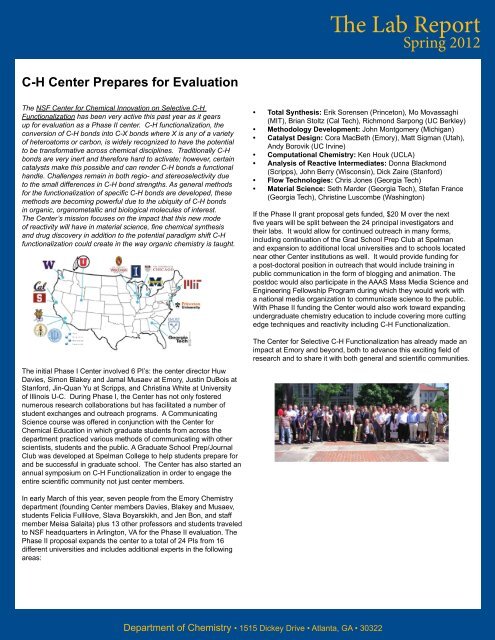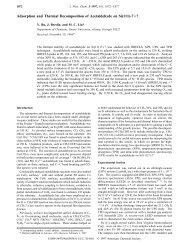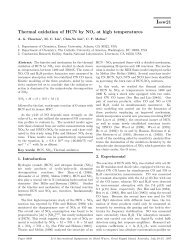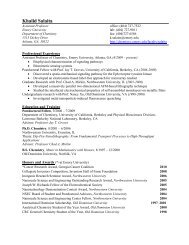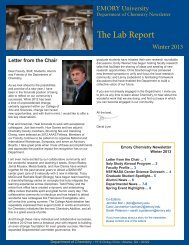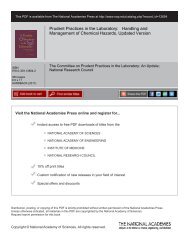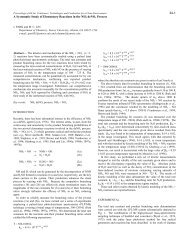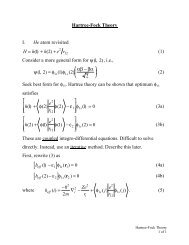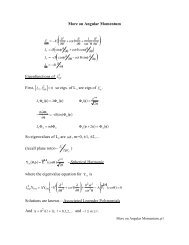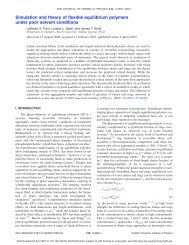The Lab Report Spring 2012 - Chemistry - Emory University
The Lab Report Spring 2012 - Chemistry - Emory University
The Lab Report Spring 2012 - Chemistry - Emory University
Create successful ePaper yourself
Turn your PDF publications into a flip-book with our unique Google optimized e-Paper software.
<strong>The</strong> <strong>Lab</strong> <strong>Report</strong><br />
<strong>Spring</strong> <strong>2012</strong><br />
C-H Center Prepares for Evaluation<br />
<strong>The</strong> NSF Center for Chemical Innovation on Selective C-H<br />
Functionalization has been very active this past year as it gears<br />
up for evaluation as a Phase II center. C-H functionalization, the<br />
conversion of C-H bonds into C-X bonds where X is any of a variety<br />
of heteroatoms or carbon, is widely recognized to have the potential<br />
to be transformative across chemical disciplines. Traditionally C-H<br />
bonds are very inert and therefore hard to activate; however, certain<br />
catalysts make this possible and can render C-H bonds a functional<br />
handle. Challenges remain in both regio- and stereoselectivity due<br />
to the small differences in C-H bond strengths. As general methods<br />
for the functionalization of specific C-H bonds are developed, these<br />
methods are becoming powerful due to the ubiquity of C-H bonds<br />
in organic, organometallic and biological molecules of interest.<br />
<strong>The</strong> Center’s mission focuses on the impact that this new mode<br />
of reactivity will have in material science, fine chemical synthesis<br />
and drug discovery in addition to the potential paradigm shift C-H<br />
functionalization could create in the way organic chemistry is taught.<br />
<strong>The</strong> initial Phase I Center involved 6 PI’s: the center director Huw<br />
Davies, Simon Blakey and Jamal Musaev at <strong>Emory</strong>, Justin DuBois at<br />
Stanford, Jin-Quan Yu at Scripps, and Christina White at <strong>University</strong><br />
of Illinois U-C. During Phase I, the Center has not only fostered<br />
numerous research collaborations but has facilitated a number of<br />
student exchanges and outreach programs. A Communicating<br />
Science course was offered in conjunction with the Center for<br />
Chemical Education in which graduate students from across the<br />
department practiced various methods of communicating with other<br />
scientists, students and the public. A Graduate School Prep/Journal<br />
Club was developed at Spelman College to help students prepare for<br />
and be successful in graduate school. <strong>The</strong> Center has also started an<br />
annual symposium on C-H Functionalization in order to engage the<br />
entire scientific community not just center members.<br />
• Total Synthesis: Erik Sorensen (Princeton), Mo Movassaghi<br />
(MIT), Brian Stoltz (Cal Tech), Richmond Sarpong (UC Berkley)<br />
• Methodology Development: John Montgomery (Michigan)<br />
• Catalyst Design: Cora MacBeth (<strong>Emory</strong>), Matt Sigman (Utah),<br />
Andy Borovik (UC Irvine)<br />
• Computational <strong>Chemistry</strong>: Ken Houk (UCLA)<br />
• Analysis of Reactive Intermediates: Donna Blackmond<br />
(Scripps), John Berry (Wisconsin), Dick Zaire (Stanford)<br />
• Flow Technologies: Chris Jones (Georgia Tech)<br />
• Material Science: Seth Marder (Georgia Tech), Stefan France<br />
(Georgia Tech), Christine Luscombe (Washington)<br />
If the Phase II grant proposal gets funded, $20 M over the next<br />
five years will be split between the 24 principal investigators and<br />
their labs. It would allow for continued outreach in many forms,<br />
including continuation of the Grad School Prep Club at Spelman<br />
and expansion to additional local universities and to schools located<br />
near other Center institutions as well. It would provide funding for<br />
a post-doctoral position in outreach that would include training in<br />
public communication in the form of blogging and animation. <strong>The</strong><br />
postdoc would also participate in the AAAS Mass Media Science and<br />
Engineering Fellowship Program during which they would work with<br />
a national media organization to communicate science to the public.<br />
With Phase II funding the Center would also work toward expanding<br />
undergraduate chemistry education to include covering more cutting<br />
edge techniques and reactivity including C-H Functionalization.<br />
<strong>The</strong> Center for Selective C-H Functionalization has already made an<br />
impact at <strong>Emory</strong> and beyond, both to advance this exciting field of<br />
research and to share it with both general and scientific communities.<br />
In early March of this year, seven people from the <strong>Emory</strong> <strong>Chemistry</strong><br />
department (founding Center members Davies, Blakey and Musaev,<br />
students Felicia Fullilove, Slava Boyarskikh, and Jen Bon, and staff<br />
member Meisa Salaita) plus 13 other professors and students traveled<br />
to NSF headquarters in Arlington, VA for the Phase II evaluation. <strong>The</strong><br />
Phase II proposal expands the center to a total of 24 PIs from 16<br />
different universities and includes additional experts in the following<br />
areas:<br />
Department of <strong>Chemistry</strong> • 1515 Dickey Drive • Atlanta, GA • 30322


